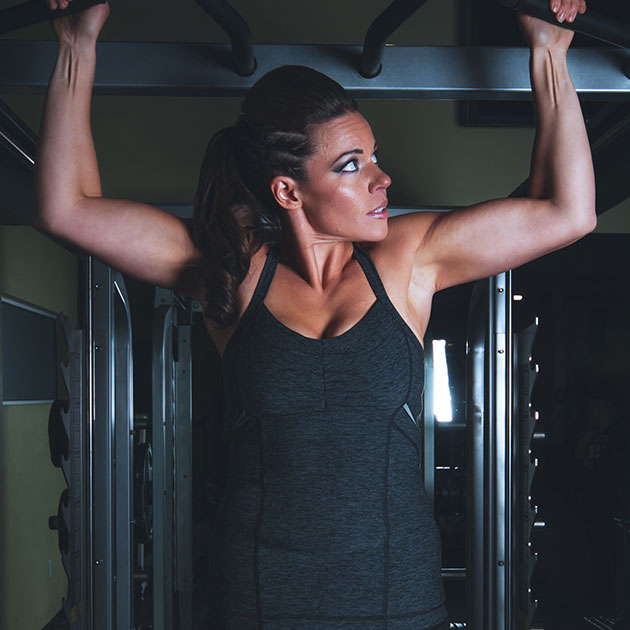Pull-ups: A How to Guide For Beginners

Pull-ups are VERY challenging, especially if you’re just getting started. Pull-ups are a closed kinetic chain activity, and work lots of the muscles in your back and shoulders. These muscles include teres major, pectoralis major, biceps brachii, infraspinatus and the latisimus dorsi and the forearms. 1 2 Regardless of your age or gender, you can do as many pull-ups as you want (within certain limits) but you have to train for them! According to the overload principle, an individual must gradually increase stresses placed upon the body during exercise training in order to enhance muscular performance. 3 Below is not a formula; it is simply a rough guide that has provided me with success!
Pull-ups are a closed kinetic chain activity, and work lots of the muscles in your back and shoulders. #performbetter @pogophysio Share on X1. Hanging
A strong grip is the foundation of a strong upper body. If you’re going to pull yourself up from a hanging position, it makes sense to get good at hanging first. Try to hang from a bar for as long as your hands will let you. Start with your hands on a bar about shoulder width apart, using an overhand grip (palms facing away) this will bias your back rather than your upper arm. To make things more challenging, try changing your leg position such as hanging leg raises, toes to bar or knees to elbows.
2. Scapular Pull-Ups
Scapular pull-ups are really good for people who have trouble activating their latissimus dorsi muscle. This muscle is the prime movers for a pull-up! The ability to hang with straight arms, and then pull your shoulder blades down your back, is an excellent way to learn how to initiate a pull up.
3. Bent over row and Body weight row
A bent over row still uses a pull action, and therefore engages similar muscles. Row’s are a good way to develop strength in the muscles in the back and allows you to start with a more manageable load.
Similarly, body weight rows work the same muscles as a pull-up, just at a different angle. If you’re just getting started and need to make the exercise easier, bend your knees and put your feet flat on the ground. As you get stronger you can straighten your legs and lay more parallel to the ground. Make sure you keep bottom lifted to ensure that you have glute activation!
4. Single Arm Kettle Bell Shoulder Press or anything overhead for that matter.
Working on grip strength, core strength and shoulder stability – all of which are important for your goal.
5. Isometrics
Isometrics are a great way to build strength. Isometrics are when a position is held for a chosen amount of time. Sustained isometric holds increase motor unit recruitment that may also help explain hypertrophic changes in muscle. Therefore, incorporating sustained holds during exercise may provide physiological changes to the targeted muscle groups. 3 For me personally, the top of the pull-up was my weakest area. So I do isometric holds in that range for 10-15 seconds. Using a step, boost or a jump to get your body to the top of the bar so that your chest is at the level of the bar. Isometrics flow nicely into Negatives… See next step!
6. Negatives
Negatives or ‘Eccentric’ muscle work is when a person starts at the top of the pull movement and slowly lowers down until their arms are straight. (Counting to three during the movement is a good tempo). This can be done using a step, partner or a little jump.
In eccentric exercise the contracting muscle is forcibly lengthened and the muscles are working to slow down the movement. 4 Eccentric muscle work is a great way to gain strength in movements that a person can’t perform concentrically yet. This is because the tension in muscle fibers when lengthening is considerably greater than when muscle fibers are shortening and the energy requirement falls substantially in comparison to concentric contractions. When muscle fibers are eccentrically lengthened ATP (a kind of cell energy) breakdown and heat production are slowed, fewer muscle fibers are required to exert a given force and there was a substantial reduction in oxygen uptake. 5
7. Assisted Pull-Ups
This is where the concentric phase begins! This is the up phase or initiation phase of a pull up and is when the muscle shortens. 4 Make sure you maintain proper pull up form throughout the movement!
- Clench your bottom and keep your abs tight throughout the exercise – try not to swing.
- Focus on pulling the bar down with your arms aiming for chest height.
- Use the least amount of assistance that you can handle.
7A: Assisted pull-ups with an Exercise Band – you can get different types of exercise bands with different levels of stretch. Put your foot in the exercise band and pull yourself up. If you’re using an exercise band, try to get a few bands of varying tension so you can decrease the resistance, as you get stronger.
7B: Assisted pull-ups with a partner – have a friend hold your feet behind you, around the pelvis or ribs and help you complete each rep.
8. Pull-Ups and More
Yay you have made it! A few things to think about:
- Bottom engaged and body tight. Make sure you are not pulling up with bent hips and knees, or “pumping” your way up. A really good, strict pull up should not recruit your hip flexors or use momentum to achieve the end result!
- Full Range of Motion. It may be easier in the beginning to limit your range but you are cheating yourself by not extending the arms all the way at the bottom of the movement. If you start or finish your pull-ups with a bent arm, you didn’t complete the pull up. Sorry.
- Pull until the bar reaches below chin (aim for your chest). Aim high and keep eye gaze forward! Think about drawing your shoulder blades down and together.
Variations: Wide grip, side-to-side, uneven pull ups or weighted pull-ups.
On a side note: Wide and reverse grip pull-ups are linked with increased shoulder injury risk (rotator cuff pathology such as impingement). 2 You shouldn’t experience any kind of pain throughout (other than muscle work) or joint pain after pull-ups. If so, you should seek professional help to improve your form.
Loulou Negoescu
Physiotherapist

Featured in the Top 50 Physical Therapy Blog
References
- Antinori F, Felici F, Figura F, Marchetti M, Ricci B. Joint moments and work in pull-ups. J Sports Med Phys Fitness. 1988; 28(2):132-7. Available from: http://www.ncbi.nlm.nih.gov/pubmed/3184911.
- Prinold JA, Bull AM. Scapula kinematics of pull-up techniques: Avoiding impingement risk with training changes. J Sci Med Sport. 2016; 19(8):629-35. DOI:10.1016/j.jsams.2015.08.002.
- Myers NL, Toonstra JL, Smith JS, Padgett CA, Uhl TL. Sustained Isometric Shoulder Contraction on Muscular Strength and Endurance: A Randomized Clinical Trial. Int J Sports Phys Ther. 2015; 10(7):1015-25. Available from: http://www.ncbi.nlm.nih.gov/pubmed/26676171.
- Proske U, Morgan DL. Muscle damage from eccentric exercise: mechanism, mechanical signs, adaptation and clinical applications. J Physiol. 2001; 537(Pt 2):333-45. Available from: http://www.ncbi.nlm.nih.gov/pubmed/11731568.
- Lorenz D, Reiman M. The role and implementation of eccentric training in athletic rehabilitation: tendinopathy, hamstring strains, and acl reconstruction. Int J Sports Phys Ther. 2011; 6(1):27-44. Available from: http://www.ncbi.nlm.nih.gov/pubmed/21655455.








